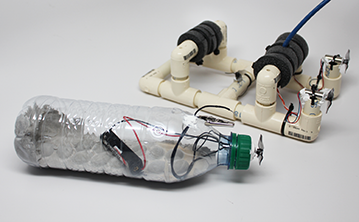

 Water is one of our basic survival needs. Humans must drink water. All life needs water for survival. With water covering 71% of the earth's surface, this realm supports living organisms as well as technologies designed to explore and exploit this realm.
Water is one of our basic survival needs. Humans must drink water. All life needs water for survival. With water covering 71% of the earth's surface, this realm supports living organisms as well as technologies designed to explore and exploit this realm.

We have developed technologies to:
Buoyancy is the key to maneuvering in this world. Buoyancy is the force that makes ships float. An understanding of buoyancy gives engineers the knowledge to control a submarine's dive and surface. Science informs engineering design. Science tells us:
Buoyancy Force =
Water Density x Volume of Submerged Object x Gravity
Basically, buoyancy results from the density of the water pushing up on the volume of an object. When analyzing any problem or challenge, it is good to understand the problem's variables and constants. This equation defines these. Gravity is a constant, 9.8N. We cannot alter gravity so let's focus on the variables in this equation, water density and object volume.
Fbuoyancy =Water Density x Volume of Object x Gravity Force
So what is Density? Matter (materials) are made up of particles attracted together to form a solid, liquid or gas. Many materials can change state with temperature and pressure. Water exists in our natural environment in all three states.

Review the chart at the left. The density of water at room temperature, 70°, is 998.02 Kg/m3. The density of cold water, 40° , is 993.5 Kg/m3. Go to the tropics and a gallon of water will be slightly easier to carry, 996.69 Kg/m3 at 80°. So you can see the relationship of density and temperature. As water temperature increases, density decreases.
What about density and buoyancy? Let's start with a simple assumption. If an object has a higher density than water, it will sink. Therefore we can hypothesis that if the density of an object is less than the density of water, it will float.
Not so simple. Volume is part of the equation.
But why does a steel ship float? Buoyancy is defined as the volume of water displaced by an object. An object sinking in a glass of water displaces (raises the water level) equal to the volume of the object. The force of buoyancy varies with the variables density and volume. Gravity force is a constant force pushing the bottle down. Buoyancy force is pushing up, supporting the load. The steel hull of a ship displaces a large volume of water.
Fbuoyancy = Water Density x Volume of Object x Gravity Force
The equation shows this relationship. As the volume of an object increases, buoyancy force increases. Maneuvering in water will require the control of diving and surfacing. Volume can be used to engineer this function.
Can a plastic bottle be engineered to maneuver in water?